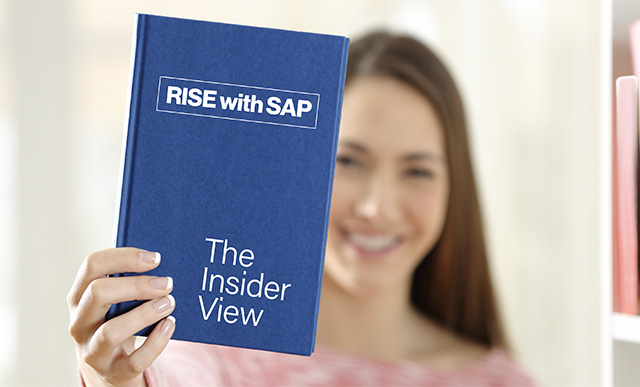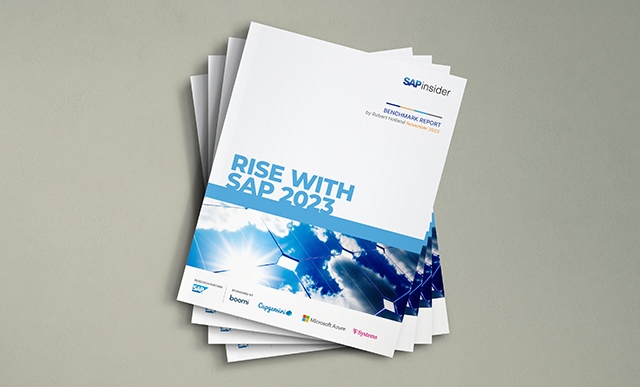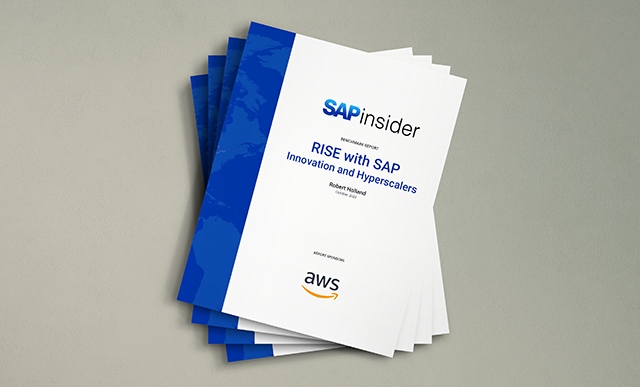RISE with SAP: Research And Trends
Meet the Authors
Key Takeaways
⇨ Some SAPinsiders report that they have limited knowledge about the RISE with SAP offering
⇨ 43% of Insiders report that GenAI and sustainability within RISE had not changed their thinking
⇨ SAP needs to do more to explore the benefits that RISE with SAP offers beyond a move to SAP S/4HANA Cloud
When it was announced in 2021, many were confused about RISE with SAP. RISE with SAP was initially presented as a Business-Transformation-as-a-Service offering that aimed to provide capabilities to transform organizations both from an infrastructure, as they moved to SAP S/4HANA Cloud, and process perspective, utilizing capabilities from newly acquired SAP Signavio. Three years on, RISE with SAP is the centerpiece of SAP’s cloud ERP agenda and something towards which SAP is increasingly pushing customers.
Despite being the focus for SAP messaging over the past three years, there are still many who report that they have limited knowledge about the offering. In recent SAPinsider research, nearly half the respondents indicated that they were at most somewhat familiar with RISE with SAP. While the proportion of respondents who are more familiar with RISE with SAP is growing, this lack of knowledge about the offering is very likely a blocker to increased adoption even with the increasing pressure that SAP is applying to customers. However, SAP needs to do more to demonstrate the benefits that RISE with SAP can bring to build on the growth the offering saw in 2023.
Chart 1
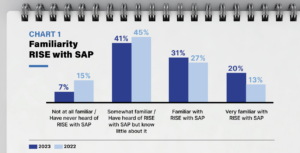
Familiarity with RISE with SAP
Part of the challenge for customers has been in the makeup of the RISE with SAP package. At the start of 2023 the offering was largely the same as it had been for the previous two years, but SAP Build was added to the offering during Sapphire and later on, the SAP Business Network was removed.
The biggest changes came towards the end of the year when RISE with SAP was split into base, premium and premium plus packages. Base is little more than a way to get customers to cloud ERP, while premium is largely analogous to the original RISE with SAP offering. However, premium plus packaging will add new generative AI capabilities to SAP S/4HANA Cloud, SAP Datasphere, SAP Sustainability Footprint Management, SAP Sustainability Control Tower and office of the CFO capabilities like Cash Management, Receivables Management, SAC Planning, and Group Reporting. While these changes are intended to provide customers with more choice when it comes to RISE with SAP, there will likely be a short-term impact on projects moving forward as they decide which option is best for their organization.
One component to RISE with SAP that saw a significant growth in understanding was that of SAP BTP. Given that SAP BTP, and the role it plays as the fabric that connects the SAP ecosystem, it is little surprise that it is much better understood than in the past. However, at the same time, the business process transformation capabilities of SAP Signavio remain one of the least understood areas of RISE with SAP. Similarly, while respondents reported that they had more knowledge about SAP Build, it remains one of the less understood areas within RISE with SAP. Given the role SAP BTP plays as the fabric that connects the SAP ecosystem, it is important for organizations to focus their enablement efforts in these areas.
Looking at what is drawing organizations to RISE with SAP, the single contract of the offering presents the largest single draw for those responding to SAPinsider research. That interest is also greater in organizations whose annual revenue exceeds $2bn, suggesting that being able to reduce multiple infrastructure and software contracts into a single contract offers significant benefits.
These large organizations also see the ability to convert existing licenses to cloud credits as a major draw, reflecting the fact that they may have either unused licenses that it makes sense to convert to cloud credits or they see greater value in subscription-based licensing than smaller organizations.
Chart 2
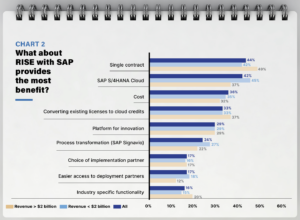
What about RISE provides the most benefit?
Smaller organizations, a proportion of which may not have an existing SAP ERP implementation, are more focused on SAP S/4HANA Cloud when looking at the benefits RISE with SAP provides. Although SAP rolled out the GROW with SAP offering during 2023 which is targeted exclusively at customers that do not have an SAP ERP deployment, SAP S/4HANA Cloud, public edition may be a good fit for these organizations. Two major benefits that may pique companies’ interests are the ability to have a clean starting point and the fact that internal teams only need to manage the application itself and not the underlying systems, as is the case with an SAP S/4HANA Cloud, private edition deployment.
One of the factors that SAP hoped would make a significant difference in interest in RISE with SAP was that of Generative AI capabilities. Although the timing of those announcements meant that those questions could not be added to the main research that SAPinsider conducted, a separate questionnaire was sent to members of the technology executive forum to gauge the impact.
While 14 percent of respondents reported that SAP’s announcements on Generative AI and sustainability innovations only being available to RISE with SAP customers had changed their thinking on the offering, 43 percent reported that their thinking had not changed. The other 43 percent of respondents indicated that they needed more information. While this does leave SAP with a window to educate customers, it is likely a much smaller change in thinking than the company had anticipated.
Chart 3
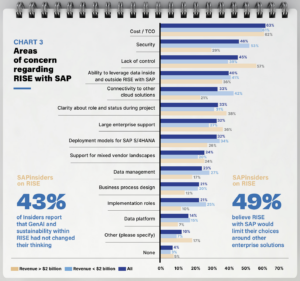
Areas of concern regarding RISE
Although RISE with SAP is the main focus of SAP’s cloud ERP efforts, and they are putting increasing pressure on customers to adopt the offering, there are significant concerns among respondents to SAPinsider research. The biggest concern is in the area of cost, regardless of the size of the respondent organization. Nearly two in three respondents from organizations of all sizes said that the cost of moving to RISE was a major concern.
Although some organizations have been able to recognize significant cost benefits from the move to RISE, in addition to streamlining infrastructure and software contract management, this has not been the case for every organization.
At the same time, nearly as many respondents from large organizations were concerned about the lack of control that might result from using RISE with SAP. Part of this concern may be around the fact that RISE with SAP requires organizations to use SAP contracted infrastructure with cloud providers instead of the infrastructure that may fall under existing enterprise agreements companies already have. This may also be connected to a concern that using
RISE with SAP may limit choices around other enterprise solutions. In fact, nearly half of those completing SAPinsider research (49 percent) reported that they believed that using RISE with SAP would limit their choices around other enterprise solutions. This proportion was even higher (54 percent) among respondents from organizations with annual revenues below $2bn.
Despite these reservations, 29 percent of leaders indicate that their organization plans on evaluating RISE with SAP while another 21 percent are currently evaluating (14 percent) or are in the process of deploying (seven percent) the offering. One in four reports that they have no plans to evaluate RISE
with SAP, while one in five indicate that they do not understand enough about RISE with SAP.
This goes back to SAP’s need to show more about the value that RISE with SAP offers, particularly in how it provides a connective backbone to other enterprise solutions through SAP BTP, and how it is integrated with other SAP solutions such as supply chain, analytics and HR.
What does this mean for SAPinsiders?
Over the past year there has been a continued growth in both knowledge of RISE with SAP and adoption of the offering. However, many organizations still have reservations about RISE, particularly when it comes to overall cost and with choices being limited around other enterprise solutions.
SAP needs to do more to explore the benefits that RISE with SAP offers beyond a move to SAP S/4HANA Cloud, and to reassure customers that RISE with SAP will fit into their increasingly diverse enterprise landscapes. No matter what organizations are planning for their ERP future, there are steps that they should take to plan for the future:
- Dedicate time to understanding RISE with SAP. While knowledge of the offering is growing, it is not possible to make an informed decision about whether to use RISE with SAP unless it is understood. It is important to ensure that teams are educated about RISE with SAP so that the best decisions can be made about future ERP strategy.
- Plan for RISE with SAP to be the default model for moving to SAP S/4HANA. While there are other options for licensing SAP S/4HANA than moving to RISE with SAP, it is important that organizations prepare for RISE with SAP being the only way to move to SAP S/4HANA. This may not happen immediately, but it is an eventuality for which SAP customers should prepare.
- Understand how RISE with SAP is changing and how it can benefit your organization. There have been significant changes to how RISE with SAP has been packaged over the last year and these are likely to continue into 2024. New features are likely to be added to incentivize customers to move to the offering, and licensing options will also probably change over time. Monitoring these changes will be key to leveraging RISE with SAP to derive the maximum benefit to your organization.



